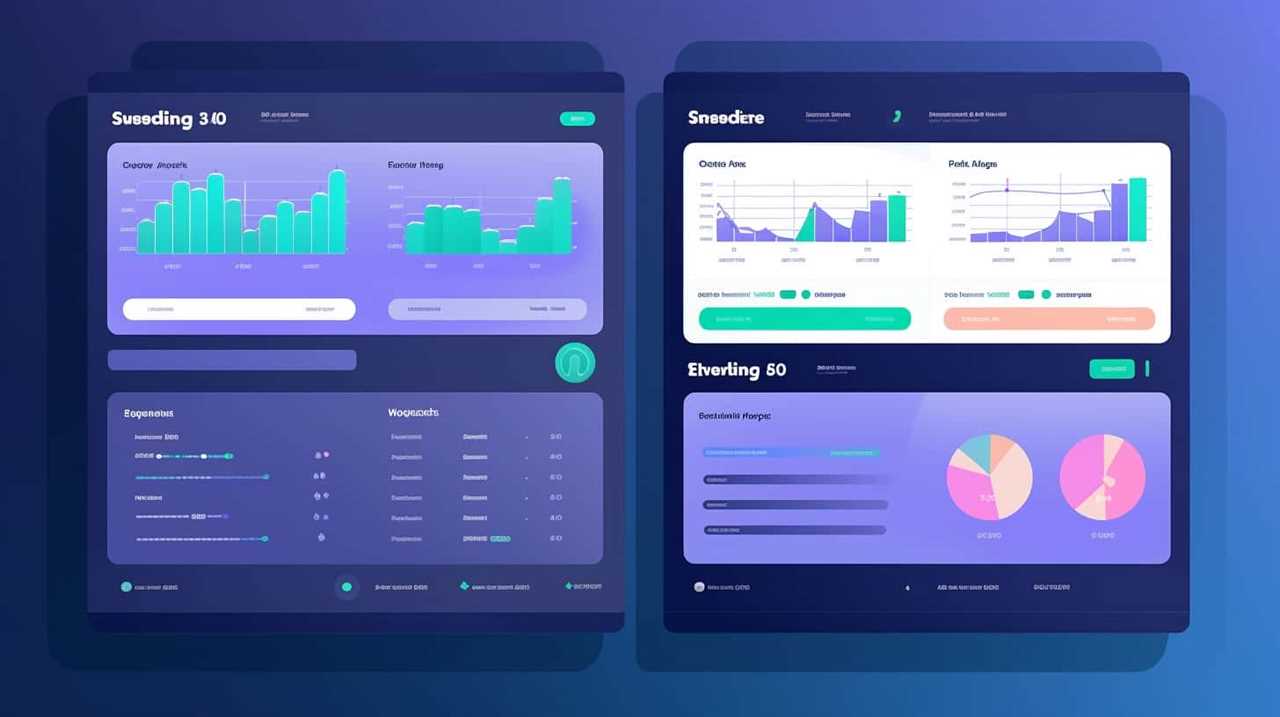Are you prepared to discover the key elements of an effective content marketing plan?
Join us as we journey into the world of captivating content that speaks directly to your target audience.
From understanding their needs to creating engaging content, we’ll show you how to strategize and evolve in this ever-changing landscape.
Get ready to liberate your brand and take your content marketing to new heights.

Let’s embark on this transformative journey together.
Key Takeaways
- Understanding the target audience is crucial for effective content marketing.
- Setting clear goals and objectives helps focus efforts and measure progress.
- Measuring content performance allows for optimization and improvement.
- Thorough research and analysis inform decision-making and strategy optimization.
Understanding the Target Audience
Understanding the target audience is crucially important in content marketing strategy as it allows us to consistently and effectively engage with them. Through target audience analysis and audience segmentation, we can gain valuable insights into their needs, preferences, and behaviors. This knowledge enables us to create content that resonates with them and addresses their specific pain points.
Setting Clear Goals and Objectives
Setting clear goals and objectives is crucial for the success of a content marketing strategy. By defining what we want to achieve, we’re able to focus our efforts and resources in the right direction.
Moreover, setting measurable goals allows us to track the performance of our content, identify areas for improvement, and make data-driven decisions to optimize our strategy.

Importance of Goal-Setting
To achieve success in a content marketing strategy, we must establish clear and specific objectives that guide our efforts. Setting goals is crucial because it provides direction, focus, and a benchmark for measuring progress. By aligning our goals with the overall business objectives, we ensure that our content marketing efforts are in line with the organization’s mission and vision.
When setting goals, it is important to consider the metrics that will be used to measure success. Metrics such as website traffic, engagement rates, and conversion rates help us evaluate the effectiveness of our content and make data-driven decisions. By regularly monitoring and analyzing these metrics, we can identify areas for improvement and make necessary adjustments to our content marketing strategy.
To illustrate the importance of goal-setting, here is a table showcasing examples of clear and specific content marketing goals and their corresponding metrics:
| Goal | Metrics |
|---|---|
| Increase brand awareness | Social media reach, website traffic |
| Generate leads | Conversion rate, lead quality |
| Establish thought leadership | Number of industry publications, speaker invitations |
| Drive customer loyalty and retention | Customer retention rate, repeat purchase rate |
Measuring Content Performance
How do we effectively measure the performance of our content marketing strategy? When it comes to measuring content effectiveness, tracking audience engagement is crucial. Here are two key ways to do it:

- Analyze website analytics: By using tools like Google Analytics, we can track metrics such as page views, bounce rate, and time on page. These insights give us a clear understanding of how our audience interacts with our content.
- Monitor social media engagement: Social media platforms provide valuable data on likes, shares, comments, and click-through rates. By keeping an eye on these metrics, we can gauge the level of engagement our content generates and adjust our strategy accordingly.
Conducting Thorough Research and Analysis
Effective content marketing strategies rely on conducting comprehensive research and analysis. Research methodologies and competitive analysis are essential components of this process. By utilizing various research methodologies, such as surveys, interviews, and data analysis, marketers can gain valuable insights into their target audience’s preferences, needs, and behavior. This helps in creating content that resonates with them and drives engagement. Additionally, conducting a competitive analysis allows marketers to understand their competitors’ strategies, identify gaps in the market, and differentiate their content. To illustrate the importance of research and analysis in content marketing, consider the following table:
| Research Methodologies | Competitive Analysis |
|---|---|
| Surveys | Identifying competitors’ content |
| Interviews | Analyzing competitors’ engagement levels |
| Data Analysis | Evaluating competitors’ positioning |
Through thorough research and analysis, content marketers can make informed decisions, optimize their strategies, and deliver content that truly meets their audience’s needs.
Developing a Unique Value Proposition
When developing a unique value proposition for our content marketing strategy, it’s crucial to focus on three key points:
- Differentiating from competitors: By differentiating ourselves, we can stand out in a crowded market and attract the attention of our target audience.
- Targeting a specific audience: By targeting a specific audience, we can tailor our content to their needs and preferences, increasing the chances of engagement and conversion.
- Solving customer pain points: Lastly, by addressing customer pain points, we can offer valuable solutions that will help build trust and loyalty with our audience.
Differentiating From Competitors
One key aspect of our content marketing strategy is to differentiate ourselves from competitors by developing a unique value proposition. In order to stand out in a crowded market, we employ various differentiating strategies that give us a competitive advantage. Here are two important ways we set ourselves apart:

- Identifying our unique strengths: We carefully analyze our strengths and identify what sets us apart from our competitors. By understanding our unique selling proposition, we can effectively communicate our value to our target audience.
- Offering exclusive content: We create high-quality, valuable content that isn’t easily found elsewhere. By providing unique insights, expert opinions, and exclusive information, we establish ourselves as thought leaders and attract a loyal following.
By implementing these differentiating strategies, we position ourselves as the go-to resource in our industry, giving us a competitive edge.
Now, let’s explore how we target our specific audience to maximize our reach and impact.
Targeting Specific Audience
To effectively target our specific audience and develop a unique value proposition, we continue the discussion from the previous subtopic by analyzing their needs and preferences. Understanding demographics and segmenting our audience is crucial in creating content that resonates with them. By doing so, we can tailor our messaging and deliver the right content to the right people at the right time.
Let’s take a closer look at how we can understand our audience better. Below is a table that outlines some key factors to consider when segmenting our audience:

| Demographic | Psychographic | Behavioral |
|---|---|---|
| Age | Interests | Purchase history |
| Gender | Values | Online behavior |
| Location | Lifestyle | Brand loyalty |
By understanding these demographics and segmenting our audience accordingly, we can develop a unique value proposition that speaks directly to their needs and desires. This will allow us to create content that is more targeted, relevant, and engaging.
Now that we have a clear understanding of our audience, we can move on to the next step: solving their pain points and providing them with valuable solutions.
Solving Customer Pain Points
To effectively address our audience’s needs and differentiate our brand, we focus on solving their pain points and developing a unique value proposition. By understanding the challenges our customers face, we can provide tailored solutions that enhance their satisfaction and build long-lasting relationships. Here’s how we approach solving customer pain points:
- Identify the problem: We conduct thorough research to identify the specific pain points our audience experiences.
- Offer solutions: Once we understand the problem, we develop innovative solutions that directly address those pain points.
- Provide valuable content: We create high-quality, engaging content that educates and empowers our audience, offering practical tips and solutions.
- Personalize the experience: We tailor our products and services to meet the unique needs of our customers, ensuring maximum satisfaction.
Creating High-Quality and Engaging Content
We believe that creating high-quality and engaging content is essential for the success of a content marketing strategy. In order to capture the attention of our audience, we must go beyond just providing information; we need to create compelling narratives and interactive experiences that resonate with them.

By telling stories that evoke emotions and spark curiosity, we can establish a genuine connection with our readers. Additionally, incorporating interactive elements like quizzes, polls, and videos can further engage our audience and keep them coming back for more.
When our content is of high quality and engages our audience, it not only builds trust and credibility but also encourages them to share it with others, amplifying our reach and impact.
With this in mind, let’s now explore how implementing effective SEO strategies can further enhance the success of our content marketing efforts.
Implementing Effective SEO Strategies
In order to enhance the success of our content marketing strategy, we actively implement effective SEO strategies. By conducting effective keyword research, we ensure that our website content is optimized for search engines. Here are two key ways we implement SEO strategies:

- Keyword Research: We conduct thorough research to identify the most relevant and high-performing keywords in our industry. This helps us understand what our target audience is searching for and allows us to optimize our content accordingly. We utilize keyword research tools to identify popular and relevant keywords. We also analyze search volume and competition to prioritize target keywords.
By implementing these effective SEO strategies, we increase the visibility of our content, attract organic traffic, and improve our website’s ranking in search engine results.
With a strong SEO foundation in place, we can now move on to the next crucial step: utilizing social media platforms to amplify our content’s reach and engagement.
Utilizing Social Media Platforms
When it comes to utilizing social media platforms for content marketing, there are two key points to consider: platform selection and targeting, as well as engagement and audience reach.
Choosing the right platforms that align with your target audience’s preferences and behaviors is crucial for effective content distribution.

Additionally, engaging with your audience through meaningful interactions and consistently delivering valuable content will help expand your reach and foster a loyal following.
Platform Selection and Targeting
Utilizing social media platforms is essential for effectively selecting and targeting the right audience for a successful content marketing strategy. In today’s digital age, platforms like Facebook, Twitter, and Instagram offer a wealth of opportunities to connect with potential customers and build brand awareness.
Here are a few key points to consider when it comes to platform selection and targeting:
- Platform customization:
- Each social media platform has its own unique features and audience demographics. It’s crucial to tailor your content and messaging to fit the platform you’re using.
- Customize your profiles, bios, and visuals to reflect your brand identity and resonate with your target audience.
- Audience segmentation:
- Take the time to understand your audience and segment them based on their demographics, interests, and behaviors.
- This will allow you to create content that speaks directly to their needs and interests, increasing engagement and driving conversions.
Engagement and Audience Reach
We can maximize engagement and audience reach by leveraging social media platforms as part of our content marketing strategy. Social media platforms provide an incredible opportunity to connect with our target audience and generate meaningful interactions. By utilizing these platforms effectively, we can not only improve engagement but also expand our reach to a wider audience.

To illustrate the importance of social media in content marketing, let’s take a look at the following table:
| Platform | Benefits |
|---|---|
| Large user base, targeted advertising | |
| Visual appeal, influencer partnerships | |
| Real-time updates, hashtag campaigns |
By strategically utilizing these platforms, we can increase engagement through targeted advertising on Facebook, leverage the visual appeal and influencer partnerships on Instagram, and create real-time updates and hashtag campaigns on Twitter.
Incorporating social media into our content marketing strategy is essential for improving engagement and expanding our reach. It allows us to connect with our audience on a more personal level, build brand awareness, and ultimately drive results.
Building a Strong Brand Identity
To build a strong brand identity, it’s essential for us to clearly define our values, mission, and unique selling proposition. This process starts with brand positioning, which involves determining the specific space we want to occupy in the market and how we want our audience to perceive us.

Once we’ve a clear brand positioning, we can develop brand messaging that effectively communicates our values, mission, and unique selling proposition to our target audience. This messaging should be consistent across all channels and touchpoints, creating a cohesive and memorable brand experience for our customers.
By building a strong brand identity, we can differentiate ourselves from competitors, establish trust and loyalty with our audience, and ultimately drive business growth.
Transitioning into the next section, consistently measuring and analyzing performance allows us to ensure that our brand identity is resonating with our target audience and achieving our desired outcomes.
Consistently Measuring and Analyzing Performance
Consistently measuring and analyzing performance allows us to effectively gauge the success of our content marketing strategy. By tracking performance and measuring effectiveness, we can identify what’s working and what needs improvement.

This data-driven approach helps us make informed decisions and optimize our content to better resonate with our target audience.
Measuring effectiveness involves monitoring key performance indicators (KPIs) such as website traffic, engagement metrics, and conversion rates. By analyzing these metrics, we can determine the impact of our content on audience behavior and whether it aligns with our marketing objectives.
Tracking performance also enables us to identify trends and patterns over time. This information helps us identify opportunities for growth and areas where we may need to pivot our strategy.
Consistently measuring and analyzing performance is essential for the success of our content marketing strategy. It empowers us to make data-driven decisions, optimize our content, and ultimately achieve our marketing goals.

Building Relationships With Influencers
Building relationships with influencers is crucial to the success of our content marketing strategy. Influencers have the power to amplify our brand’s message and reach a wider audience. Here are two key reasons why influencer partnerships should be a priority in our influencer marketing strategies:
- Trust and Credibility: Influencers have built a loyal following based on trust and credibility. By collaborating with them, we can leverage their authority and establish ourselves as a trusted source in our industry.
- Increased Reach and Engagement: Influencers have a dedicated audience that actively engages with their content. By partnering with them, we can tap into their network and gain access to a larger pool of potential customers.
Leveraging User-Generated Content
How can we effectively leverage user-generated content to enhance our content marketing strategy? User-generated content (UGC) provides a valuable opportunity for brands to tap into the authentic voices of their audience, building trust and credibility. By incorporating UGC into our content marketing strategy, we can create a more engaging and relatable experience for our target audience. To leverage UGC effectively, we need to ensure that it aligns with our brand values and resonates with our audience. Here is a table showcasing three key benefits of leveraging user-generated content:
| Benefits of Leveraging UGC |
|---|
| Builds authenticity |
| Establishes trust |
| Increases engagement |
Incorporating UGC not only adds a human touch to our content but also allows our audience to see real people using and endorsing our products or services. This fosters authenticity and trust, ultimately leading to increased engagement and brand loyalty.
Implementing a Content Distribution Plan
To effectively implement a content distribution plan, we must carefully strategize the channels and platforms through which we’ll distribute our content. This involves identifying the most effective content distribution channels for reaching our target audience and maximizing our content’s visibility.

Here are two key considerations when creating a content distribution plan:
- Content Distribution Channels
- Social Media Platforms: Utilize popular platforms like Facebook, Instagram, and Twitter to reach a wide audience and engage with users.
- Email Marketing: Build an email list and send out regular newsletters or updates to keep subscribers informed and engaged.
- Content Promotion Strategies
- Influencer Marketing: Collaborate with influencers in your industry who can help promote your content to their audience.
- SEO Optimization: Optimize your content for search engines to improve its visibility and organic reach.
Utilizing Email Marketing Campaigns
We found success in our content distribution plan by leveraging email marketing campaigns.
Email marketing targeting allows us to reach our audience directly, delivering personalized and relevant content straight to their inbox. By optimizing our email campaigns, we can ensure that our messages are engaging, compelling, and drive action.
We segment our email lists based on demographics, interests, and behavior to ensure that we’re sending the right message to the right people at the right time. We also constantly monitor and analyze our email campaign metrics to identify areas for improvement and refine our strategies.

Incorporating multimedia elements, such as videos and interactive graphics, into our emails can further enhance engagement and provide a more immersive experience for our audience.
Incorporating Multimedia Elements
When it comes to content marketing, incorporating multimedia elements can greatly enhance the effectiveness of visual storytelling and increase engagement with your audience.
Visual storytelling allows you to convey your brand’s message through compelling visuals, capturing attention and evoking emotions.
Visual Storytelling Effectiveness
Using a wide array of engaging multimedia elements enhances the effectiveness of visual storytelling in content marketing strategies. By incorporating visual storytelling techniques and leveraging the impact of visual content, marketers can captivate their audience and deliver their brand message more effectively.

Here are two key ways in which multimedia elements contribute to the success of visual storytelling:
- Stunning visuals: Incorporating high-quality images, videos, infographics, and animations not only grabs attention but also helps convey complex information in a visually appealing manner.
- Interactive features: Implementing interactive elements such as quizzes, surveys, and clickable hotspots allows the audience to actively engage with the content, making the storytelling experience more immersive and memorable.
With these techniques, marketers can create compelling narratives that resonate with their audience, leading to increased engagement and brand loyalty.
Now, let’s delve into the next section about engagement through multimedia.
Engagement Through Multimedia
Incorporating multimedia elements enhances engagement in content marketing strategies by providing an immersive and captivating experience for the audience. Engaging visuals and interactive content are powerful tools that grab attention and hold it. By using multimedia, such as videos, infographics, and interactive quizzes, brands can convey their message in a more dynamic and compelling way.

Visuals have the ability to evoke emotions, tell stories, and convey complex information in a digestible format. Interactive content, on the other hand, allows the audience to actively participate and engage with the brand, making the experience more memorable and enjoyable.
Continuously Adapting and Evolving the Strategy
To achieve success in content marketing, we must constantly adapt and evolve our strategy. In today’s fast-paced digital landscape, staying relevant is crucial for capturing and retaining the attention of our audience.
Here are two key ways we can continuously adapt and evolve our content marketing strategy:
- Embrace Data-Driven Insights:
- Regularly analyze data to identify trends and patterns in audience behavior.
- Use these insights to inform content creation and distribution strategies, ensuring we’re delivering the right message to the right people at the right time.
- Stay Agile and Experiment:
- Be open to trying new approaches and formats to keep our content fresh and engaging.
- Test different platforms, formats, and messaging to see what resonates most with our audience.
Frequently Asked Questions
How Can I Effectively Measure the Success of My Content Marketing Strategy?
To effectively measure the success of our content marketing strategy, we rely on ROI analysis and tracking performance. By analyzing data and metrics, we can gauge the impact of our efforts and make informed decisions for future content initiatives.

What Role Does Storytelling Play in Creating High-Quality and Engaging Content?
Storytelling techniques, when incorporated into content creation, play a vital role in capturing the attention of our audience and creating high-quality, engaging content. Here are some storytelling tips to help us achieve success.
How Can I Ensure That My Content Is Optimized for Search Engines and Improves My SEO Rankings?
To ensure our content is optimized for search engines and improves our SEO rankings, we focus on keyword research, creating high-quality and valuable content, and optimizing our meta tags and headers.
What Are Some Effective Ways to Build a Strong Brand Identity Through Content Marketing?
Building credibility and developing a consistent voice are key to building a strong brand identity through content marketing. It’s important to engage your audience with informative and strategic content that speaks to their desire for liberation.
How Can I Leverage User-Generated Content to Enhance the Effectiveness of My Content Marketing Strategy?
To enhance our content marketing strategy, we leverage user-generated content to drive user engagement. By tapping into the creativity and authenticity of our audience, we create a powerful and liberated brand experience.

Conclusion
In conclusion, a successful content marketing strategy requires:
- A deep understanding of the target audience.
- Clear goals and objectives.
- Thorough research and analysis.
- A unique value proposition.
- High-quality and engaging content.
- A well-planned distribution plan.
- Effective email marketing campaigns.
- Incorporation of multimedia elements.
- Continuous adaptation and evolution of the strategy.
By following these key principles, businesses can create compelling and impactful content that resonates with their audience and drives desired results.









